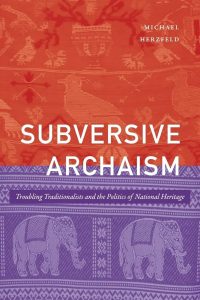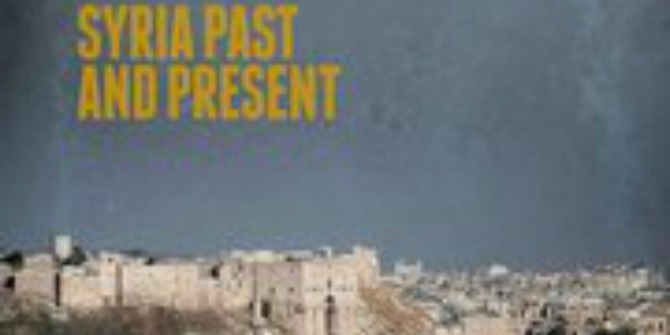In Subversive Archaism: Troubling Traditionalists and the Politics of National Heritage, Michael Herzfeld considers how marginalised groups use nationalist discourses of tradition to challenge state authority. Drawing on ethnography in Greece and Thailand, Olivia Porter finds that Herzfeld’s concept of subversive archaism provides a useful framework for understanding state-resistant thought and activity in other contexts. A longer version of this post was originally published on the LSE Southeast Asia Blog.
Subversive Archaism: Troubling Traditionalists and the Politics of National Heritage. Michael Herzfeld. Duke University Press. 2022.
 “The nation-state depends on obviousness because, in reality, its own primacy is not an obvious or logical necessity at all. It is presented as a given, and most people accept it as such. Implicitly or explicitly, subversive archaists question it” (123).
“The nation-state depends on obviousness because, in reality, its own primacy is not an obvious or logical necessity at all. It is presented as a given, and most people accept it as such. Implicitly or explicitly, subversive archaists question it” (123).
The excerpt above encapsulates the central thesis of the social anthropologist and heritage studies scholar Michael Herzfeld’s Subversive Archaism: Troubling Traditionalists and the Politics of National Heritage. That being said, that the modern nation-state is widely accepted as the primary unit of territorial and cultural organisation, but that there are a group of people, subversive archaists, who question this rhetoric. Subversive archaism challenges the notion that the nation-state, constrained by bureaucratic organisation and with an emphasis on an ethnonational state, is the only acceptable form of polity. Subversive archaists offer an alternative polity, one legitimised by understandings of heritage that date back further than the homogenous ‘collective heritage’ proposed in state-generated discourses for the purpose of creating a ubiquitous representation of national unity (2). As Herzfeld suggests, subversive archaists instead reach into the past to reclaim older and often more inclusive polities and understandings of belonging, and in doing so, they utilise ancient heritage to challenge the authority, and very notion, of the modern nation-state.
Subversive archaists instead reach into the past to reclaim older and often more inclusive polities and understandings of belonging
Herzfeld examines the concept of subversive archaism through comparative ethnography, drawing on long-term ethnographic fieldwork with two communities: the Zoniani of Zoniana in Crete, Greece, and the Chao Pom of Pom Mahakan, Bangkok, Thailand. At first, the two communities appear geographically and culturally distinctively dissimilar. However, they share one important feature neither country has ever been officially colonised by a Western state. Herzfeld ascribes the term “crypto-colonialism”, a ‘disguised’ form of colonialism, to both Greece and Thailand, as states that despite never being officially colonised, were both under constant pressure to conform to Western cultural, political, and economic demands. Herzfeld explains that such countries place a great emphasis on their political independence and cultural integrity having never been colonised, yet many forms of their independence were dictated by Western powers.
In identifying themselves with the heroic past of the nation state, [subversive archaists] legitimise their own status as rightful members of the nations in which they now find themselves marginalised.
In Chapter Two, Herzfeld explores the historical origins of the images and symbols mimicked by subversive archaists to challenge the dominant, often ethnonationalist, narrative of the nation-state. Subversive archaists ransack official historiography and claim nationalist heroes as their own, and in identifying themselves with the heroic past of the nation state, they legitimise their own status as rightful members of the nations in which they now find themselves marginalised. Rather than reject official narratives, subversive archaists appropriate them, in ways that undermine state bureaucracy. For example, the Zoniani (and many Cretans) do not reject the official historiography of the state, which emphasises continuity with Hellenic culture. In fact, they fiercely defend it, and go one further, by citing etymological similarities between Cretan dialects that bear traces of an early regional version of Classical Greek. In doing so, they make claims that they have a better understanding of history than the state bureaucrats.
Chapter Three explores belonging and remoteness through kinship structures and geographical location. Herzfeld highlights how the nation-state uses the symbolic distancing of communities as remote or inaccessible as a tool to marginalize communities. Pom Mahakan is located on the outskirts of Bangkok, the capital of Thailand, and nowadays Zoniana is accessible by road. Herzfeld argues that the characterisation of these communities as remote and inaccessible is applied by hostile bureaucracies rather than by the communities themselves as an extreme form of intentional political marginalisation.
Zoniani society is still structured by a patrilineal clan system, and Chao Pom society by a mandala-based moeang system. These structures represent an older, and alternative, system of polity to the modern bureaucratic nation-state.
In Chapter Four, Herzfeld proposes that we reframe the assumption that religion shapes cities and instead think about how cosmology shapes polities. In particular, how Zoniani society is still structured by a patrilineal clan system, and Chao Pom society by a mandala-based moeang system. These structures represent an older, and alternative, system of polity to the modern bureaucratic nation-state. For example, the Chao Pom embrace religious and ethnic minorities, arguing that diversity is representative of true Thai society, and that tolerance and generosity are true Thai ideals. The notion of polity itself is the focus of Chapter Five which explores how Pom Mahakan and Zoniana have cosmologically distinct identities that, when conceptualised as part of the same system as the nation-state, both mimic and challenge the state’s legitimacy, thus inviting official violence.
Herzfeld argues that what sets subversive archaists apart from the “state-shunning groups” described by Scott […] is their ‘demand for reciprocal respect and their capacity to play subversive games with the state’s own rhetoric and symbolism’
Herzfeld explains how neither the Zoniani nor Chao Pom fit into the James C. Scott’s concept of “the art of not being governed,” applied to Zomian anarchists who flee from state centres into remote mountainous regions in northeastern India; the central highlands of Vietnam; the Shan Hills in northern Myanmar; and the mountains of Southwest China. Herzfeld argues that what sets subversive archaists apart from the “state-shunning groups” described by Scott, but also makes them representative of a widespread form of resistance to state hegemony, is their “demand for reciprocal respect and their capacity to play subversive games with the state’s own rhetoric and symbolism”. Arguably, the reason that the Zoniani and Chao Pom can demand ‘reciprocal respect’ is related to their ethnic, historical, and cultural affiliation with the majority that marginalises them. The ethnic minorities of Zomia do not benefit from the same types of affiliation.
Ultimately, Herzfeld’s model of subversive archaism offers us an example of understanding how marginalised groups challenge and subvert authority
Ultimately, Herzfeld’s model of subversive archaism offers us an example of understanding how marginalised groups challenge and subvert authority. Herzfeld is not proposing that any given group needs to fit neatly into the category of subversive archaists, but rather how some groups reach back into the past to offer an alternative future. In Chapter Eight, Herzfeld explores the future of subversive archaist communities, and also how subversive archaism might mutate into nationalist, and potentially dangerous, movements. The Chao Pom embrace ethnic and religious minorities on the grounds that acceptance and inclusion are true Thai ideals. However, there are dangers to invoking ideologies attached to ‘true’ ideologies of national cultures and traditions, and other types of communities can utilise the rhetoric of subversive archaism. For example, in the wake of the COVID-19 pandemic, “antimaskers” use the language of “liberty” and “democracy” against the modern bureaucratic state, seeking to transform the present into an idealised national past.
I was initially sceptical about who qualified as a subversive archaist. At first, the term seemed too rigid, a community had to be marginalised by the state authority, but associate themselves with the majority and use the language of the state to legitimise themselves their alternative polity. Then, the term seemed too broad, it is not specific to a certain geography, ethnic identity, or religion, and can apply to religious and non- religious groups. Subversive archaism might help us make sense of the Chao Pom and the Zoniani, but who are the subversive archaists of the contemporary world? Then, one morning, when listening to a podcast from the BBC World Service covering the inauguration of India’s controversial new parliament building, I heard a line of argument, from the Indian historian Pushpesh Pant, that struck me as being rooted in subversive archaism.
When asked about the aesthetics of the new parliament building, Pant remarked “I think it is a monstrosity… If the whole idea was to demolish whatever the British, the colonial masters, had built, and have a symbolic resurrection of Indian architecture, I would even go, stick my leg out and say Hindu architecture, it should have been an impressive tribute to generations of Indian architectural tradition Vastu Shastra. Vastu Shastra is the Indian science of building, architecture.” He goes on to say: “How does this symbolise India?”
I suspect that given the rise of nationalist movements across the globe, the tools of subversive archaism, rather than subversive archaists groups per se, will become all the more visible.
In invoking the Vastu Shastra, the ancient Sanskrit manuals of Indian architecture, and the Sri Yantra, the mystical diagram used in the Shri Vidya school of Hinduism, Pant demonstrates his deep understanding of ancient Indian architecture and imagery. And in doing so, he highlights the missed opportunities of the bureaucratic state in designing their new parliament building to create a building that was truly representative of archaic Indian architecture. He does what Herzfeld describes as “playing the official arbiters of cultural excellence [here, the BJP] at their own game”. I suspect that given the rise of nationalist movements across the globe, the tools of subversive archaism, rather than subversive archaists groups per se, will become all the more visible.
This book review is published by the LSE Southeast Asia blog and LSE Review of Books blog as part of a collaborative series focusing on timely and important social science books from and about Southeast Asia. This review gives the views of the author, and not the position of the LSE Review of Books blog, the LSE Southeast Asia Blog, or the London School of Economics and Political Science.
Main Image Credit: daphnusia images on Shutterstock.







